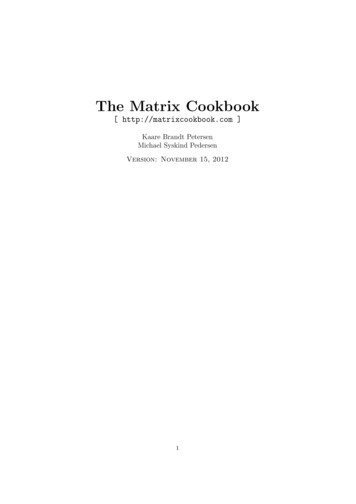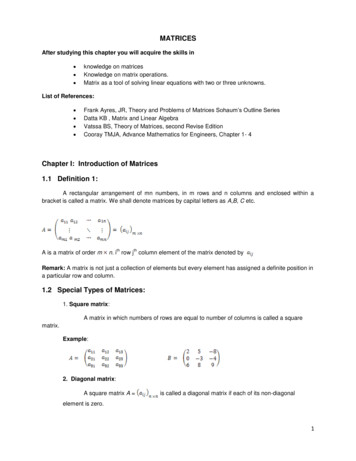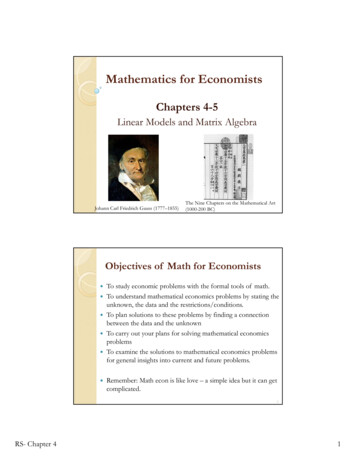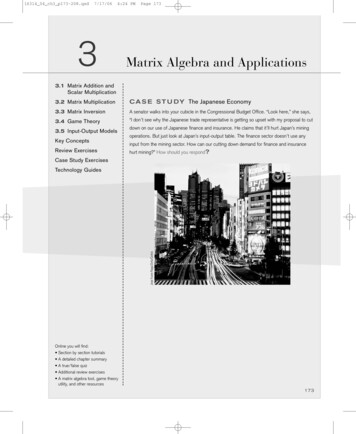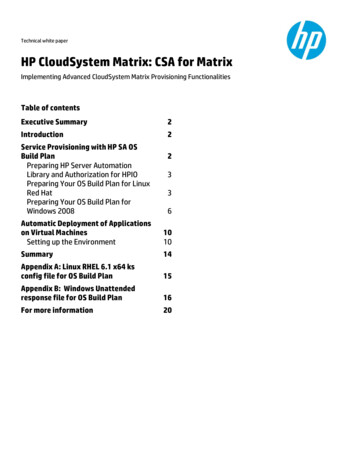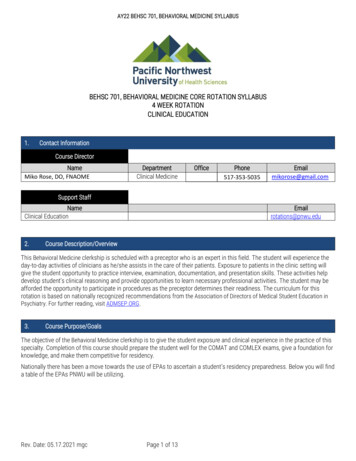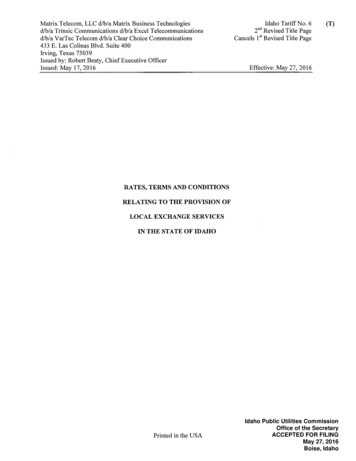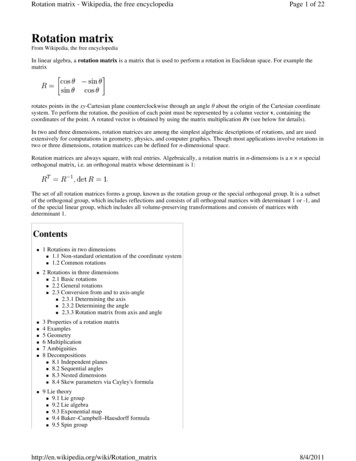
Transcription
Rotation matrix - Wikipedia, the free encyclopediaPage 1 of 22Rotation matrixFrom Wikipedia, the free encyclopediaIn linear algebra, a rotation matrix is a matrix that is used to perform a rotation in Euclidean space. For example thematrixrotates points in the xy-Cartesian plane counterclockwise through an angle θ about the origin of the Cartesian coordinatesystem. To perform the rotation, the position of each point must be represented by a column vector v, containing thecoordinates of the point. A rotated vector is obtained by using the matrix multiplication Rv (see below for details).In two and three dimensions, rotation matrices are among the simplest algebraic descriptions of rotations, and are usedextensively for computations in geometry, physics, and computer graphics. Though most applications involve rotations intwo or three dimensions, rotation matrices can be defined for n-dimensional space.Rotation matrices are always square, with real entries. Algebraically, a rotation matrix in n-dimensions is a n n specialorthogonal matrix, i.e. an orthogonal matrix whose determinant is 1:.The set of all rotation matrices forms a group, known as the rotation group or the special orthogonal group. It is a subsetof the orthogonal group, which includes reflections and consists of all orthogonal matrices with determinant 1 or -1, andof the special linear group, which includes all volume-preserving transformations and consists of matrices withdeterminant 1.Contents 1 Rotations in two dimensions 1.1 Non-standard orientation of the coordinate system 1.2 Common rotations 2 Rotations in three dimensions 2.1 Basic rotations 2.2 General rotations 2.3 Conversion from and to axis-angle 2.3.1 Determining the axis 2.3.2 Determining the angle 2.3.3 Rotation matrix from axis and angle 3 Properties of a rotation matrix4 Examples5 Geometry6 Multiplication7 Ambiguities8 Decompositions 8.1 Independent planes 8.2 Sequential angles 8.3 Nested dimensions 8.4 Skew parameters via Cayley's formula 9 Lie theory 9.1 Lie group 9.2 Lie algebra 9.3 Exponential map 9.4 Baker–Campbell–Hausdorff formula 9.5 Spin grouphttp://en.wikipedia.org/wiki/Rotation matrix8/4/2011
Rotation matrix - Wikipedia, the free encyclopedia Page 2 of 2210 Infinitesimal rotations11 Conversions 11.1 Quaternion 11.2 Polar decomposition 11.3 Axis and angle 11.4 Euler angles12 Uniform random rotation matrices13 See also14 Notes15 References16 External linksRotations in two dimensionsIn two dimensions every rotation matrix has the following form:.This rotates column vectors by means of the following matrix multiplication:.So the coordinates (x',y') of the point (x,y) after rotation are:,.A counterclockwise rotation of avector through angle θ. The vector isinitially aligned with the x-axis.The direction of vector rotation is counterclockwise if θ is positive (e.g. 90 ), andclockwise if θ is negative (e.g. -90 ).Non-standard orientation of the coordinate systemIf a standard right-handed Cartesian coordinate system is used, with the x axis tothe right and the y axis up, the rotation R(θ) is counterclockwise. If a left-handedCartesian coordinate system is used, with x directed to the right but y directeddown, R(θ) is clockwise. Such non-standard orientations are rarely used inmathematics but are common in 2D computer graphics, which often have theorigin in the top left corner and the y-axis down the screen or page.[1]See below for other alternative conventions which may change the sense of therotation produced by a rotation matrix.Common rotationsParticularly useful are the matrices for 90 and 180 rotations:A rotation through angle θ with nonstandard axes.(90 counterclockwise rotation)http://en.wikipedia.org/wiki/Rotation matrix8/4/2011
Rotation matrix - Wikipedia, the free encyclopediaPage 3 of 22(180 rotation in either direction – a half-turn)(270 counterclockwise rotation, the same as a 90 clockwise rotation)Rotations in three dimensionsSee also: Rotation representation.Basic rotationsThe following three basic (gimbal-like) rotation matrices rotate vectors about the x, y, or z axis, in three dimensions:Each of these basic vector rotations typically appears counter-clockwise when the axis about which they occur pointstoward the observer, and the coordinate system is right-handed. Rz, for instance, would rotate toward the y-axis a vectoraligned with the x-axis. This is similar to the rotation produced by the above mentioned 2-D rotation matrix. See belowfor alternative conventions which may apparently or actually invert the sense of the rotation produced by these matrices.General rotationsOther rotation matrices can be obtained from these three using matrix multiplication. For example, the productrepresents a rotation whose yaw, pitch, and roll are α, β, and γ, respectively. Similarly, the productrepresents a rotation whose Euler angles are α, β, and γ (using the y-x-z convention for Euler angles).The orthogonal matrix (post-multiplying a column vector) corresponding to a clockwise/left-handed rotation with Eulerangles φ,θ,ψ, with x-y-z convention, is given by:http://en.wikipedia.org/wiki/Rotation matrix8/4/2011
Rotation matrix - Wikipedia, the free encyclopediaPage 4 of 22Conversion from and to axis-angleEvery rotation in three dimensions is defined by its axis — a direction that is left fixed by the rotation — and its angle —the amount of rotation about that axis (Euler rotation theorem).There are several methods to compute an axis and an angle from a rotation matrix (see also axis-angle). Here, we onlydescribe the method based on the computation of the eigenvectors and eigenvalues of the rotation matrix. It is alsopossible to use the trace of the rotation matrix.Determining the axisGiven a rotation matrix R, a vector u parallel to the rotation axis must satisfysince the rotation of around the rotation axis must result in . The equationabove may be solved for which is unique up to a scalar factor.Further, the equation may be rewrittenwhich shows that is the null space of R I. Viewed another way, is aneigenvector of R corresponding to the eigenvalue λ 1 (every rotation matrixmust have this eigenvalue).Determining the angleTo find the angle of a rotation, once the axis of the rotation is known, select avector perpendicular to the axis. Then the angle of the rotation is the anglebetween and.A rotation R around axis u can bedecomposed using 3 endomorphismsP, (I - P), and Q (click to enlarge).Rotation matrix from axis and angleFor some applications, it is helpful to be able to make a rotation with a given axis. Given a unit vector u (ux, uy, uz),where ux2 uy2 uz2 1, the matrix for a rotation by an angle of θ about an axis in the direction of u isThis can be written more concisely aswhereis the cross product matrix of u, is the tensor product and I is the Identity matrix. This is a matrix form ofRodrigues' rotation formula, withIf the 3D space is right-handed, this rotation will be counterclockwise for an observer placed so that the axis u goes in hisor her direction (Right-hand rule).http://en.wikipedia.org/wiki/Rotation matrix8/4/2011
Rotation matrix - Wikipedia, the free encyclopediaPage 5 of 22Properties of a rotation matrixIn three dimensions, for any rotation matrix, where a is a rotation axis and θ a rotation angle,(i.e.,is an orthogonal matrix)(i.e, the determinant ofis 1) (whereThe eigenvalues of where i is the standard imaginary unit with the property i2 1The trace ofisequivalent to the sum of its eigenvalues. is the identity matrix)areSome of these properties can be generalised to any number of dimensions. In other words, they hold for any rotationmatrix.For instance, in two dimensions the properties hold with the following exceptions: a is not a given axis, but a point (rotation center) which must coincide with the origin of the coordinate system inwhich the rotation is represented.Consequently, the four elements of the rotation matrix depend only on θ, hence we write, rather thanThe eigenvalues ofareThe trace ofisequivalent to the sum of its eigenvalues.Examples The 2 2 rotation matrix corresponds to a 90 planar rotation.The transpose of the 2 2 matrix The 3 3 matrix has determinant 1, but its transpose is not its inverse,so it is not a rotation matrix.The 4 3 matrix is not square, and so cannot be a rotation matrix; yetMTM yields a 3 3 identity matrix (the columns areorthonormal).The 4 4 matrix describes an isoclinic rotation, a rotation through equalangles (180 ) through two orthogonal planes.The 5 5 rotation matrixis its inverse, but since its determinant is 1 this is not arotation matrix; it is a reflection across the line 11y 2x.The 3 3 rotation matrix corresponds to a 30 rotation around the x axis inthree-dimensional space.The 3 3 rotation matrix corresponds to a rotation of approximately -74 aroundthe axis ( 1 3,2 3,2 3) in three-dimensional space.The 3 3 permutation matrixhttp://en.wikipedia.org/wiki/Rotation matrix8/4/2011
Rotation matrix - Wikipedia, the free encyclopediais a rotation matrix, as is the matrix of any evenpermutation, and rotates through 120 about the axis x y z.Page 6 of 22rotates vectors in the plane of the first two coordinateaxes 90 , rotates vectors in the plane of the next twoaxes 180 , and leaves the last coordinate axis unmoved.GeometryIn Euclidean geometry, a rotation is an example of an isometry, a transformation that moves points without changing thedistances between them. Rotations are distinguished from other isometries by two additional properties: they leave (atleast) one point fixed, and they leave "handedness" unchanged. By contrast, a translation moves every point, a reflectionexchanges left- and right-handed ordering, and a glide reflection does both.A rotation that does not leave "handedness" unchanged is an improper rotation or a rotoinversion.If we take the fixed point as the origin of a Cartesian coordinate system, then every point can be given coordinates as adisplacement from the origin. Thus we may work with the vector space of displacements instead of the points themselves.Now suppose (p1, ,pn) are the coordinates of the vector p from the origin, O, to point P. Choose an orthonormal basisfor our coordinates; then the squared distance to P, by Pythagoras, iswhich we can compute using the matrix multiplicationA geometric rotation transforms lines to lines, and preserves ratios of distances between points. From these properties wecan show that a rotation is a linear transformation of the vectors, and thus can be written in matrix form, Qp. The fact thata rotation preserves, not just ratios, but distances themselves, we can state asorBecause this equation holds for all vectors, p, we conclude that every rotation matrix, Q, satisfies the orthogonalitycondition,Rotations preserve handedness because they cannot change the ordering of the axes, which implies the special ion matrix8/4/2011
Rotation matrix - Wikipedia, the free encyclopediaPage 7 of 22Equally important, we can show that any matrix satisfying these two conditions acts as a rotation.MultiplicationThe inverse of a rotation matrix is its transpose, which is also a rotation matrix:The product of two rotation matrices is a rotation matrix:For n greater than 2, multiplication of n n rotation matrices is not commutative.Noting that any identity matrix is a rotation matrix, and that matrix multiplication is associative, we may summarize allthese properties by saying that the n n rotation matrices form a group, which for n 2 is non-abelian. Called a specialorthogonal group, and denoted by SO(n), SO(n,R), SOn, or SOn(R), the group of n n rotation matrices is isomorphic tothe group of rotations in an n-dimensional space. This means that multiplication of rotation matrices corresponds tocomposition of rotations, applied in left-to-right order of their corresponding matrices.AmbiguitiesThe interpretation of a rotation matrix can be subject to manyambiguities.Alias or alibi transformationThe change in a vector's coordinates can be due to a turnof the coordinate system (alias) or a turn of the vector(alibi). Any rotation can be legitimately described bothways, as vectors and coordinate systems actually rotatewith respect to each other. Throughout this article, wechose the alibi approach to describe rotations.Pre-multiplication or post-multiplicationThe vector can be pre-multiplied by a rotation matrix (Rv,where v is a column vector), or post-multiplied by it (vR,where v is a row vector). Throughout this article, wedescribed rotations produced by means of a preAlias and alibi rotationsmultiplication.Right- or left-handed coordinatesThe matrix and the vector can be represented with respectto a right-handed or left-handed coordinate system. Throughout the article, we assumed a right-handed orientation,unless otherwise specified.http://en.wikipedia.org/wiki/Rotation matrix8/4/2011
Rotation matrix - Wikipedia, the free encyclopediaPage 8 of 22Vectors or formsThe vector space has a dual space of linear forms, and the matrix can act on either vectors or forms.In most cases the effect of the ambiguity is equivalent to the effect of a transposition of the rotation matrix.DecompositionsIndependent planesConsider the 3 3 rotation matrixIf Q acts in a certain direction, v, purely as a scaling by a factor λ, then we haveso thatThus λ is a root of the characteristic polynomial for Q,Two features are noteworthy. First, one of the roots (or eigenvalues) is 1, which tells us that some direction is unaffectedby the matrix. For rotations in three dimensions, this is the axis of the rotation (a concept that has no meaning in anyother dimension). Second, the other two roots are a pair of complex conjugates, whose product is 1 (the constant term ofthe quadratic), and whose sum is 2 cos θ (the negated linear term). This factorization is of interest for 3 3 rotationmatrices because the same thing occurs for all of them. (As special cases, for a null rotation the "complex conjugates" areboth 1, and for a 180 rotation they are both 1.) Furthermore, a similar factorization holds for any n n rotation matrix. Ifthe dimension, n, is odd, there will be a "dangling" eigenvalue of 1; and for any dimension the rest of the polynomialfactors into quadratic terms like the one here (with the two special cases noted). We are guaranteed that the characteristicpolynomial will have degree n and thus n eigenvalues. And since a rotation matrix commutes with its transpose, it is anormal matrix, so can be diagonalized. We conclude that every rotation matrix, when expressed in a suitable coordinatesystem, partitions into independent rotations of two-dimensional subspaces, at most n 2 of them.The sum of the entries on the main diagonal of a matrix is called the trace; it does not change if we reorient thecoordinate system, and always equals the sum of the eigenvalues. This has the convenient implication for 2 2 and 3 3rotation matrices that the trace reveals the angle of rotation, θ, in the two-dimensional (sub-)space. For a 2 2 matrix thetrace is 2 cos(θ), and for a 3 3 matrix it is 1 2 cos(θ). In the three-dimensional case, the subspace consists of all vectorsperpendicular to the rotation axis (the invariant direction, with eigenvalue 1). Thus we can extract from any 3 3 rotationmatrix a rotation axis and an angle, and these completely determine the rotation.Sequential anglesThe constraints on a 2 2 rotation matrix imply that it must have the formhttp://en.wikipedia.org/wiki/Rotation matrix8/4/2011
Rotation matrix - Wikipedia, the free encyclopediaPage 9 of 22with a2 b2 1. Therefore we may set a cos θ and b sin θ, for some angle θ. To solve for θ it is not enough to look ata alone or b alone; we must consider both together to place the angle in the correct quadrant, using a two-argumentarctangent function.Now consider the first column of a 3 3 rotation matrix,Although a2 b2 will probably not equal 1, but some value r2 1, we can use a slight variation of the previouscomputation to find a so-called Givens rotation that transforms the column tozeroing b. This acts on the subspace spanned by the x and y axes. We can then repeat the process for the xz subspace tozero c. Acting on the full matrix, these two rotations produce the schematic formShifting attention to the second column, a Givens rotation of the yz subspace can now zero the z value. This brings thefull matrix to the formwhich is an identity matrix. Thus we have decomposed Q asAn n n rotation matrix will have (n 1) (n 2) 2 1, orentries below the diagonal to zero. We can zero them by extending the same idea of stepping through the columns with aseries of rotations in a fixed sequence of planes. We conclude that the set of n n rotation matrices, each of which has n2entries, can be parameterized by n(n 1)/2 angles.In three dimensions this restates in matrix form an observation made by Euler, somathematicians call the ordered sequence of three angles Euler angles. However, thesituation is somewhat more complicated than we have so far indicated. Despite the smalldimension, we actually have considerable freedom in the sequence of axis pairs we use; andhttp://en.wikipedia.org/wiki/Rotation matrixxzxw xzyw xyxw xyzwyxyw yxzw yzyw yzxw8/4/2011
Rotation matrix - Wikipedia, the free encyclopediawe also have some freedom in the choice of angles. Thus we find many different conventionsemployed when three-dimensional rotations are parameterized for physics, or medicine, orchemistry, or other disciplines. When we include the option of world axes or body axes, 24different sequences are possible. And while some disciplines call any sequence Euler angles,others give different names (Euler, Cardano, Tait-Bryan, Roll-pitch-yaw) to differentsequences.Page 10 of 22zyzw zyxw zxzw zxywxzxb yzxb xyxb zyxbyxyb zxyb yzyb xzybzyzb xyzb zxzb yxzbOne reason for the large number of options is that, as noted previously, rotations in threedimensions (and higher) do not commute. If we reverse a given sequence of rotations, we get a different outcome. Thisalso implies that we cannot compose two rotations by adding their corresponding angles. Thus Euler angles are notvectors, despite a similarity in appearance as a triple of numbers.Nested dimensionsA 3 3 rotation matrix likesuggests a 2 2 rotation matrix,is embedded in the upper left corner:This is no illusion; not just one, but many, copies of n-dimensional rotations are found within (n 1)-dimensionalrotations, as subgroups. Each embedding leaves one direction fixed, which in the case of 3 3 matrices is the rotation axis.For example, we havefixing the x axis, the y axis, and the z axis, respectively. The rotation axis need not be a coordinate axis; if u (x,y,z) is aunit vector in the desired direction, thenhttp://en.wikipedia.org/wiki/Rotation matrix8/4/2011
Rotation matrix - Wikipedia, the free encyclopediaPage 11 of 22where cθ cos θ, sθ sin θ, is a rotation by angle θ leaving axis u fixed.A direction in (n 1)-dimensional space will be a unit magnitude vector, which we may consider a point on a generalizedsphere, Sn. Thus it is natural to describe the rotation group SO(n 1) as combining SO(n) and Sn. A suitable formalism isthe fiber bundle,where for every direction in the "base space", Sn, the "fiber" over it in the "total space", SO(n 1), is a copy of the "fiberspace", SO(n), namely the rotations that keep that direction fixed.Thus we can build an n n rotation matrix by starting with a 2 2 matrix, aiming its fixed axis on S2 (the ordinary spherein three-dimensional space), aiming the resulting rotation on S3, and so on up through Sn 1. A point on Sn can be selectedusing n numbers, so we again have n(n 1)/2 numbers to describe any n n rotation matrix.In fact, we can view the sequential angle decomposition, discussed previously, as reversing this process. The compositionof n 1 Givens rotations brings the first column (and row) to (1,0, ,0), so that the remainder of the matrix is a rotationmatrix of dimension one less, embedded so as to leave (1,0, ,0) fixed.Skew parameters via Cayley's formulaMain article: Skew-symmetric matrixWhen an n n rotation matrix, Q, does not include 1 as an eigenvalue, so that none of the planar rotations of which it iscomposed are 180 rotations, then Q I is an invertible matrix. Most rotation matrices fit this description, and for them wecan show that (Q I)(Q I) 1 is a skew-symmetric matrix, A. Thus AT A; and since the diagonal is necessarily zero, andsince the upper triangle determines the lower one, A contains n(n 1)/2 independent numbers. Conveniently, I A isinvertible whenever A is skew-symmetric; thus we can recover the original matrix using the Cayley transform,which maps any skew-symmetric matrix A to a rotation matrix. In fact, aside from the noted exceptions, we can produceany rotation matrix in this way. Although in practical applications we can hardly afford to ignore 180 rotations, theCayley transform is still a potentially useful tool, giving a parameterization of most rotation matrices withouttrigonometric functions.In three dimensions, for example, we have (Cayley 1846)http://en.wikipedia.org/wiki/Rotation matrix8/4/2011
Rotation matrix - Wikipedia, the free encyclopediaPage 12 of 22If we condense the skew entries into a vector, (x,y,z), then we produce a 90 rotation around the x axis for (1,0,0), aroundthe y axis for (0,1,0), and around the z axis for (0,0,1). The 180 rotations are just out of reach; for, in the limit as x goesto infinity, (x,0,0) does approach a 180 rotation around the x axis, and similarly for other directions.Lie theoryLie groupWe have established that n n rotation matrices form a group, the special orthogonal group, SO(n). This algebraicstructure is coupled with a topological structure, in that the operations of multiplication and taking the inverse (whichhere is merely transposition) are continuous functions of the matrix entries. Thus SO(n) is a classic example of atopological group. (In purely topological terms, it is a compact manifold.) Furthermore, the operations are not onlycontinuous, but smooth, so SO(n) is a differentiable manifold and a Lie group (Baker (2003); Fulton & Harris (1991)).Most properties of rotation matrices depend very little on the dimension, n; yet in Lie group theory we see systematicdifferences between even dimensions and odd dimensions. As well, there are some irregularities below n 5; forexample, SO(4) is, anomalously, not a simple Lie group, but instead isomorphic to the product of S3 and SO(3).Lie algebraAssociated with every Lie group is a Lie algebra, a linear space equipped with a bilinear alternating product called abracket. The algebra for SO(n) is denoted byand consists of all skew-symmetric n n matrices (as implied by differentiating the orthogonality condition, I QTQ).The bracket, [A1,A2], of two skew-symmetric matrices is defined to be A1A2 A2A1, which is again a skew-symmetricmatrix. This Lie algebra bracket captures the essence of the Lie group product via infinitesimals.For 2 2 rotation matrices, the Lie algebra is a one-dimensional vector space, multiples ofHere the bracket always vanishes, which tells us that, in two dimensions, rotations commute. Not so in any higherdimension. For 3 3 rotation matrices, we have a three-dimensional vector space with the convenient basisThe Lie brackets of these generators are as followshttp://en.wikipedia.org/wiki/Rotation matrix8/4/2011
Rotation matrix - Wikipedia, the free encyclopediaPage 13 of 22We can conveniently identify any matrix in this Lie algebra with a vector in R3,Under this identification, the so(3) bracket has a memorable description; it is the vector cross product,The matrix identified with a vector v is also memorable, becauseNotice this implies that v is in the null space of the skew-symmetric matrix with which it is identified, because v v isalways the zero vector.Exponential mapConnecting the Lie algebra to the Lie group is the exponential map, which we define using the familiar power series forex (Wedderburn 1934, §8.02),For any skew-symmetric A, exp(A) is always a rotation matrix.An important practical example is the 3 3 case, where we have seen we can identify every skew-symmetric matrix with avector ω uθ, where u (x,y,z) is a unit magnitude vector. Recall that u is in the null space of the matrix associated withω, so that if we use a basis with u as the z axis the final column and row will be zero. Thus we know in advance that theexponential matrix must leave u fixed. It is mathematically impossible to supply a straightforward formula for such abasis as a function of u (its existence would violate the hairy ball theorem), but direct exponentiation is possible, andyieldswhere c cos θ 2, s sin θ 2. We recognize this as our matrix for a rotation around axis u by angle θ. We also note thatthis mapping of skew-symmetric matrices is quite different from the Cayley transform discussed earlier.In any dimension, if we choose some nonzero A and consider all its scalar multiples, exponentiation yields rotationhttp://en.wikipedia.org/wiki/Rotation matrix8/4/2011
Rotation matrix - Wikipedia, the free encyclopediaPage 14 of 22matrices along a geodesic of the group manifold, forming a one-parameter subgroup of the Lie group. More broadly, theexponential map provides a homeomorphism between a neighborhood of the origin in the Lie algebra and a neighborhoodof the identity in the Lie group. In fact, we can produce any rotation matrix as the exponential of some skew-symmetricmatrix, so for these groups the exponential map is a surjection.Baker–Campbell–Hausdorff formulaSuppose we are given A and B in the Lie algebra. Their exponentials, exp(A) and exp(B), are rotation matrices, which wecan multiply. Since the exponential map is a surjection, we know that for some C in the Lie algebra, exp(A)exp(B) exp(C), and we writeWhen exp(A) and exp(B) commute (which always happens for 2 2 matrices, but not higher), then C A B, mimickingthe behavior of complex exponentiation. The general case is given by the BCH formula, a series expanded in terms of thebracket (Hall 2004, Ch. 3; Varadarajan 1984, §2.15). For matrices, the bracket is the same operation as the commutator,which detects lack of commutativity in multiplication. The general formula begins as follows.Representation of a rotation matrix as a sequential angle decomposition, as in Euler angles, may tempt us to treatrotations as a vector space, but the higher order terms in the BCH formula reveal that to be a mistake.We again take special interest in the 3 3 case, where [A,B] equals the cross product, A B. If A and B are linearlyindependent, then A, B, and A B can be used as a basis; if not, then A and B commute. And conveniently, in thisdimension the summation in the BCH formula has a closed form (Engø 2001) as αA βB γ(A B).Spin groupThe Lie group of n n rotation matrices, SO(n), is a compact and path-connected manifold, and thus locally compact andconnected. However, it is not simply connected, so Lie theory tells us it is a kind of "shadow" (a homomorphic image) ofa universal covering group. Often the covering group, which in this case is the spin group denoted by Spin(n), is simplerand more natural to work with (Baker 2003, Ch. 5; Fulton & Harris 1991, pp. 299–315).In the case of planar rotations, SO(2) is topologically a circle, S1. Its universal covering group, Spin(2), is isomorphic tothe real line, R, under addition. In other words, whenever we use angles of arbitrary magnitude, which we often do, weare essentially taking advantage of the convenience of the "mother space". Every 2 2 rotation matrix is produced by acountable infinity of angles, separated by integer multiples of 2π. Correspondingly, the fundamental group of SO(2) isisomorphic to the integers, Z.In the case of spatial rotations, SO(3) is topologically equivalent to three-dimensional real projective space, RP3. Itsuniversal covering group, Spin(3), is isomorphic to the 3-sphere, S3. Every 3 3 rotation matrix is produced by twoopposite points on the sphere. Correspondingly, the fundamental group of SO(3) is isomorphic to the two-element group,Z2. We can also describe Spin(3) as isomorphic to quaternions of unit norm under multiplication, or to certain 4 4 realmatrices, or to 2 2 complex special unitary matrices.Concretely, a unit quaternion, q, withproduces the rotation matrixhttp://en.wikipedia.org/wiki/Rotation matrix8/4/2011
Rotation matrix - Wikipedia, the free encyclopediaPage 15 of 22This is our third version of this matrix, here as a rotation around non-unit axis vector (x,y,z) by angle 2θ, where cos θ wand sin θ (x,y,z) . (The proper sign for sin θ is implied once the signs of the axis components are decided.)Many features of this case are the same for higher dimensions. The coverings are all two-to-one, with SO(n), n 2,having fundamental group Z2. The natural setting for these groups is within a Clifford algebra. And the action of therotations is produced by a kind of "sandwich", denoted by qvq .Infinitesimal rotationsThe matrices in the Lie algebra are not themselves rotations; the skew-symmetric matrices are derivatives, proportionaldifferences of rotations. An actual "differential rotation", or infinitesimal rotation matrix has the formwhere dθ is vanishingly small. These matrices do not satisfy all the same properties as ordinary finite rotation matricesunder the usual treatment of infinitesimals (Goldstein, Poole & Safko 2002, §4.8). To understand what this means,considerWe first test the orthogonality condition, QTQ I. The product isdiffering from an identity matrix by second order infinitesimals, which we discard. So to first order, an infinitesimalrotation matrix is an orthogonal matrix. Next we examine the square of the matrix.
Rotation matrix From Wikipedia, the free encyclopedia In linear algebra, a rotation matrix is a matrix that is used to perform a rotation in Euclidean space. For example the matrix rotates points in the xy-Cartesian plane counterclockwise through an angle θ about the origin of the Cartesian coordinate system. To perform the rotation, the position of each point must be represented by a column .
